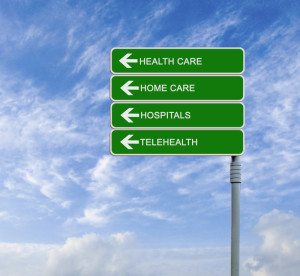Since March 2020, telehealth volume has increased at rates we would never have anticipated. As Dr. Rasu Shrestha, EVP & Chief Strategy & Transformation Officer at Atrium Health, said during a panel at the recent CHIME21 Spring Forum, “It was an overnight success 30 years in the making”. Indeed, when there were no other choices, clinicians and patients were quick to adapt.
the recent CHIME21 Spring Forum, “It was an overnight success 30 years in the making”. Indeed, when there were no other choices, clinicians and patients were quick to adapt.
But what do patients really think of telehealth a year later? The COVID-19 Healthcare Coalition recently published the Telehealth Impact: Patient Survey Analysis. The aims of their research were to determine:
- How well did telehealth serve the clinical needs of patients during the COVID-19 pandemic?
- For what reasons did patients seek care through telehealth?
- What were the strengths and weaknesses of telehealth related to quality of care?
- What are patients’ expectations for the use of telehealth after the pandemic?
The 20-question survey was open to persons 18 years or older who had at least one telehealth encounter between March 1, 2020, and January 30, 2021.Survey responders included 2,007 persons from across the U.S. who received telehealth during the pandemic.
The findings were highlighted in an mHealth Intelligence article “COVID-19 Telehealth Delivery Reaps High Patient Satisfaction”, by Hannah Nelson on April 15, 2021. The results are very encouraging for the future of telehealth.
- 83% reported good overall visit quality
- 78% felt their health concern could be addressed via telehealth
- 50% would delay their care if they didn’t have telehealth access during COVID-19
- 78% said their virtual care visits were with their regular provider highlighting telehealth capability to maintain patient-provider relationship
- 83% felt patient-provider communication was strong during their virtual care visits
- 76% said telehealth removed transportation as a care access barrier
- 79% agreed it was easy to use virtual care technology but patients 65+ were least likely to agree
- Over 75% said they would like to continue using telehealth for chronic disease management and about 70% want to continue to use for medical management
Commenting on the results, Jay Schnitzer, MD, PhD, MITRE’s Chief Medical and Technology Officer and co-chair of the coalition, said, “Both physicians and patients overwhelmingly agree that telehealth is one byproduct of the pandemic that can and should continue on in the ‘next normal’. COVID-19 has highlighted how our healthcare system needs more tools to serve patients safely and conveniently, and telehealth, when done right, has firmly established itself as an effective option in the patient-care toolbox of today and the future.”
The report closes with this summary statement: “Given this favorable, early experience with telehealth, we anticipate that telehealth will continue to be an integral component of healthcare in the months and years to come. These findings will help to inform providers, payors, and regulators now working to establish the policies and practices that will guide our transition to the “new normal.””
Dr. Joseph Kvedar is a telehealth expert who knows it has been decades in the making. He has been working in this space since the mid-90’s when he founded Partners Connected Health. I learned a lot from him when we were colleagues at Partners HealthCare (now called Mass General Brigham). He is a Harvard professor, senior advisor for virtual care at Mass General Brigham, chair of the American Telemedicine Association, and author of several books. Dr. Kvedar noted in a February interview on This Week in Health IT, “Telehealth has become a household word, but we’re now learning what it means to be in implementation mode versus proof-of-concept or experimentation mode”. And he says two key challenges still remain – privacy concerns and clinician adoption. Check out his full interview, “Telehealth – Where It Works and Where It Doesn’t with ATA Chairman”, for more insights.
It appears that the ‘overnight success’ has resulted in high satisfaction amongst patients and we will continue to see a new level of telehealth use post pandemic.
What does my household think of telehealth? For my 65+ year old tech savvy husband who has had several virtual visits the past year, ease of use was not an issue. Once he is in the patient portal, has filled out his pre-visit questions, been put in the virtual waiting room, and his physician comes on it is just like any other Zoom meeting. Count us in!
